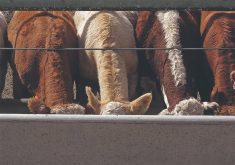The beef sector needs to position its meat as a premium product and forget about trying to duke it out with farmed fish and commercial chicken production, says one of the world’s best-known food-marketing experts.
Fish and chicken are “the two big meats” because they have the best feed conversion ratios, David Hughes said at the recent Global Conference on Sustainable Beef.
“In developing countries where incomes are increasing, as they change their diets, the meats they move towards are chicken and fish because they are more affordable,” said Hughes, emeritus professor of food marketing at Imperial College, London whose expertise has earned him the moniker of ‘Dr. Food.’
Read Also

Farming Smarter receives financial boost from Alberta government for potato research
Farming Smarter near Lethbridge got a boost to its research equipment, thanks to the Alberta government’s increase in funding for research associations.
“What’s the message from a beef point of view? Keep a long way from that fight. Because if we get involved in that fight, we’ll get our clocks cleaned.”
And being in the premium market can be a good thing for the beef sector, he added.
“As I wander around the world, looking at the price of beef in retail stores, it’s at least twice the price of the next meat down,” he said. “We’re in the premium meats. I think we should celebrate that.”
Moreover, global consumption for all types of meat has been rising for 30 years and that trend should continue for at least another two decades, he said.
“The long-term global demand for meat is strong, but it is volatile. You can expect to see strong growth over time, but it’s never a straight line.”
The challenges
But there are challenges to positioning beef in premium markets. One is salmon.
“Look at the success of sushi around the world,” said Hughes. “Every country I go to, it’s a snack or it’s a meal and it’s right in the heartland of premium snacks.”
Another is that demand for meat in developed, higher-income countries is static, if not declining, for a host of reasons — including consumer concerns about healthy eating, price, animal welfare, livestock’s impact on the environment, and food safety.
“A large part of the world is actively out there trying to reduce meat consumption,” he said. “I think we should acknowledge that — not necessarily embrace it, but come to terms with it. ”
An aging population is another challenge as consumers don’t eat meat as often as they age, and they favour smaller portions. A related issue is the push by some less developed countries — including China, the biggest global driver of consumption trends for every major food product — to reduce meat consumption for both health and environmental reasons.
Then there’s the growing popularity of faux meat products such as Quorn, a British product created from a fungus that goes through a fermentation process to create a meat substitute that tries to mimic the texture and taste of meat. The move to a more plant-based diet is partly driven by environmental concerns, but also by the perception that it’s healthier.
“Few consumers indicate that they will reduce consumption for environmental reasons, but more indicate that they would reduce meat consumption for health reasons,” Hughes said.
However, consumers are also being deluged by information about meat’s environmental impact.
“Because of perceptions, the beef industry is right bang in the centre of the bull’s-eye,” he said.
Words matter
People are also changing the way they eat. Millennials in particular are more likely to consume mini meals or snacks during the day, and make fewer meals at home.
“This has a profound impact on the industry in which we work,” said Hughes. “We tend to eat out more and people don’t buy beef, they buy a meal.
“Cooking has become about purchasing components and putting them together. You used to go shopping for ingredients, but that time is now long gone.”
Not only are sales of ready-to-eat meals skyrocketing, so is consumer interest in health and wellness, and also stories about a product and its social impact.
“It’s about value and about values — don’t underestimate that. I see that in every country. In the increasing middle class, they’re interested in values.”
The beef industry also has an opportunity to boost margins by embracing “adjectives” such as free range, grass fed, organic, or dry aged.
“The real challenge is to work out which adjectives the consumer values and is willing to pay more for,” he said.
Part of that involves putting the spotlight on individual producers.
“Farmers have become fashionable. People want to know more about you and what you do,” he said.
But as consumers become more interested in farmers, producers have to become more environmentally conscious because people now expect their food to be produced in a sustainable manner.
“Consumers won’t pay more for environmentally (sustainable products), they just expect more,” said Hughes. “You don’t get a premium for being green, but if you’re not, there’s a serious discount.”
















